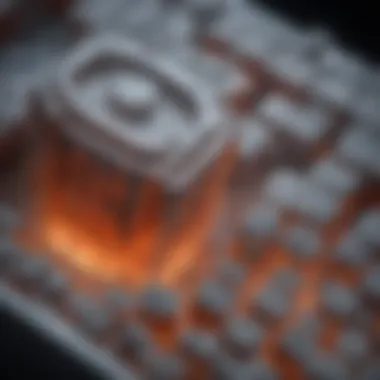Micro Coolers: A Comprehensive Overview of Technology


Intro
Micro coolers have emerged as critical components in numerous applications, where efficient thermal management is paramount. The rise in device miniaturization, coupled with demand for enhanced performance, has accelerated the need for innovative cooling technologies. Micro coolers serve a vital role in various sectors, including electronics, telecommunications, automotive, and biomedical industries. This article investigates these miniaturized cooling systems, offering insights into their operational principles, design considerations, and material choices. It also examines the current market landscape and anticipates future trends in micro cooling technology.
Research Context
Background and Rationale
The exploration of micro coolers is rooted in the increasing complexity of modern devices that generate substantial heat. As technology advances, devices shrink in size while performance demands rise. In this context, traditional cooling mechanisms often fall short. Micro coolers are designed to address these challenges, allowing for efficient thermal management in compact, high-performance formats.
Understanding the mechanics behind these devices is crucial for engineers and researchers aiming to enhance reliability and longevity in electronic systems.
"Micro coolers not only enhance the performance of devices but also contribute to sustainability by prolonging component life."
Literature Review
Extensive research has highlighted the importance of micro coolers in various applications. Studies have shown that employing advanced cooling solutions improves thermal efficiency and reduces energy consumption. Research articles have documented the progress in materials science, emphasizing the role of thermoelectric materials and microfabrication techniques in improving micro cooler performance. Notable works include investigations into materials like bismuth telluride and silicon in the development of efficient cooling systems.
Such studies provide valuable insights into design considerations and the operational principles that define the effectiveness of these miniature devices.
Methodology
Research Design
The methodology employed in exploring micro coolers encompasses a multi-faceted approach. This includes analyzing existing literature, conducting experiments, and engaging with industry case studies. The aim is to not only understand theoretical frameworks but also real-world applications across various fields.
Data Collection Methods
Data collection involved a comprehensive review of research papers, patents, and market analyses. Field Data was gathered through interviews with industry experts and engineers involved in micro cooler development. This dual approach ensures that the findings reflect both scholarly insights and practical experience.
The analysis of these elements provides a nuanced understanding of how micro coolers function, their design intricacies, and the material choices that underpin their effectiveness. The outcome is a thorough examination that will be beneficial for professionals and researchers alike.
Prologue to Micro Coolers
Micro coolers are crucial components in the realm of thermal management, particularly in applications where space is a premium. These compact devices play an essential role in regulating temperatures for various electronic systems. The discussion surrounding micro coolers is significant, as they not only enhance the performance of devices but also influence their longevity and reliability.
Definition and Importance
A micro cooler is a device designed to dissipate heat at a micro or nano scale. Its primary function is to maintain thermal equilibrium in sensitive electronic components, thus preventing damage from overheating. The importance of micro coolers cannot be understated in sectors such as electronics, automotive, and biomedical engineering, where heat dissipation is critical. They ensure that systems operate within their designated thermal envelopes, enhancing both performance and lifetime. As devices become smaller and more powerful, the necessity for effective cooling solutions increases, positioning micro coolers as essential tools in modern engineering. Their design must consider factors such as efficiency, size, and integration capabilities, making them a focal point in technology development.
Historical Context
The evolution of micro coolers reflects broader advancements in technology. In the 1960s and 1970s, initial cooling systems were bulky and not suitable for miniaturized electronics. The need for improved thermal management arose as the microelectronics industry burgeoned. As transistors became smaller and more densely packed onto chips, conventional cooling methods were inadequate.
By the 1990s, micro cooling technologies began developing, addressing these challenges. Innovations like thermoelectric coolers emerged, revolutionizing small-scale temperature control. Since then, research and development have propelled this area forward, spurring innovations that continue to shape industries today. Understanding the historical context of micro coolers provides insight into their current design and application, showcasing a trajectory focused on efficiency and compactness.
Principles of Operation
Understanding the principles of operation for micro coolers is essential. This knowledge helps engineers and researchers design more effective systems. Micro coolers rely on a few core concepts from thermal management, and each one plays a vital role in their efficiency and application. By diving into these principles, we can unveil how micro coolers function and the benefits they bring to various industries.
Thermal Management Fundamentals
Thermal management is the science of regulating temperature in systems. Micro coolers are pivotal in this domain by preventing overheating in electronic devices, semiconductor components, and other thermal-sensitive applications. The primary objective is to maintain optimum performance. High temperatures can lead to early failures and inefficiencies in devices.
In many cases, heat generated from devices must be dissipated quickly. Micro coolers facilitate this process by employing principles of thermal conduction and convection. Effective thermal management not only improves the lifespan of components but also enhances energy efficiency. These factors are critical as devices become smaller and more powerful, leading to increased heat generation.
Heat Transfer Mechanisms
Micro coolers utilize multiple heat transfer mechanisms. Primarily, they rely on conduction, convection, and radiation. Each mechanism has distinct characteristics and applications.
- Conduction involves heat transfer through materials. In micro coolers, ensuring high thermal conductivity is crucial. Materials like copper or aluminum are often chosen for their effective heat conduction properties.
- Convection is the process of heat transfer through fluids. Micro coolers may leverage forced air or liquid flows to enhance cooling. This helps in quickly moving heat away from critical components.
- Radiation occurs when heat dissipation happens through electromagnetic waves. While not the main method employed in micro coolers, it still can play a supporting role in specific environments.
The effectiveness of these mechanisms can vary significantly based on the design and application of the cooling system. Engineers must carefully consider them when designing micro cooler devices.


Cooling Technologies Overview
The realm of micro cooling encompasses various technologies. It can be categorized broadly into two main types: active and passive cooling solutions. Each serves a particular purpose in thermal management.
Active Cooling Solutions
Active cooling solutions rely on external power sources to operate, enhancing the cooling effect substantially. They are often characterized by their ability to provide precise temperature control. Thermoelectric coolers are a prime example. These coolers utilize the Peltier effect, where an electric current passes through two different materials to create a temperature difference.
- Key characteristic: Their ability to achieve accurate temperature regulation.
- Benefits: Suitable for complex systems requiring significant cooling, like high-performance electronics.
- Unique feature: Effective in smaller spaces where traditional cooling systems cannot fit.
However, active solutions also have disadvantages. They consume more energy and may generate additional heat, which requires management. The balance between performance and energy consumption is a critical consideration.
Passive Cooling Solutions
In contrast, passive cooling solutions do not require external power to function. They rely purely on natural heat dissipation principles. An example is heat sinks made from materials with high thermal conductivity.
- Key characteristic: Simplicity in design and operation.
- Benefits: They are energy-efficient and require little to no maintenance.
- Unique feature: Often smaller and lighter, making them ideal for portable devices or applications where space is a concern.
However, passive cooling has limitations in environments with high thermal loads, where it might not be sufficient to maintain desired temperatures.
In summary, selecting between active and passive cooling solutions involves considering specific application needs, heat loads, and space constraints. Understanding the principles of operation empowers stakeholders to design superior systems.
Design Considerations
The design of micro coolers is crucial in ensuring their effectiveness and efficiency in thermal management. This section will discuss key elements such as size and form factor, material selection, and integration with existing systems. Understanding these aspects enables engineers and manufacturers to create optimal cooling solutions tailored to specific applications.
Size and Form Factor
Size plays a vital role in the functionality of micro coolers. Compact designs are necessary for integration into various devices, especially in electronics where space is limited. A smaller cooler can facilitate better airflow, enhancing heat dissipation. The form factor also influences the placement flexibility, which is essential in advanced systems requiring precise thermal control. However, striking a balance between size and cooling efficiency can be a challenging task.
Material Selection
Thermal Conductivity Affects
Material selection directly impacts the thermal performance of micro coolers. Thermal conductivity is a critical characteristic that determines how efficiently a material can transfer heat. Copper, for example, is often regarded as the gold standard due to its high thermal conductivity. This property enables it to conduct heat quickly away from sensitive components. However, while copper is effective, its weight can be a disadvantage in portable applications. Thus, alternative materials such as aluminum, which is lighter and still offers good conductivity, are also popular choices.
When selecting materials, understanding trade-offs is essential. Choices such as Graphene, although currently more costly, may revolutionize thermal management with their remarkable conductivity in future models.
Durability and Reliability
Durability and reliability significantly affect the longitudinal success of micro coolers. The materials used must withstand environmental stresses such as temperature fluctuations and physical impacts. For instance, ceramic materials provide a superior advantage as they are less prone to wear and degradation compared to metals. This longevity means lower replacement costs and improved overall performance over time.
In addition, a reliable cooler should maintain consistent thermal performance over its lifecycle. Any failure in this regard could lead to overheating and potential device malfunction. Hence, selecting durable materials is not just about performance but also about ensuring user satisfaction and device longevity.
Integration with Existing Systems
Integrating micro coolers with existing systems is essential in maximizing their efficiency. Compatibility with current designs can often present challenges. It requires engineers to account for various structural and functional attributes. The ease of installation also determines whether a cooling solution is favorable.
Micro coolers must be designed to fit seamlessly into systems like computer servers, medical devices, and automotive applications without requiring extensive modifications. This compatibility ensures that thermal management solutions enhance performance without compromising the integrity of existing technologies. Thus, thoughtful consideration of integration challenges is vital in the design phase.
Types of Micro Coolers
Understanding the various types of micro coolers is critical for assessing their applicability in different industries. Micro coolers are essential in ensuring efficiency in thermal management processes. Each type has unique features and benefits, making them suitable for specific applications.
Thermoelectric Coolers
Thermoelectric coolers, or Peltier devices, operate on the principle of thermoelectric effect. This technology utilizes the flow of electric current through two dissimilar conductors to produce a temperature difference. Thermoelectric coolers are solid-state devices, which means they have no moving parts. This characteristic leads to several advantages.
- Compact Size: These coolers can be made very small, which is beneficial in applications with limited space.
- Reliability: With no moving parts, they tend to be more reliable over time.
- Temperature Control: They allow for precise temperature regulation, which is critical in many electronic applications.
- Environmentally Friendly: They do not use harmful refrigerants, providing a more sustainable cooling solution.


However, thermoelectric coolers may not be as energy-efficient as other methods, particularly for larger cooling tasks. They are best suited for compact applications where their size and reliability outweigh their higher energy demand.
Vapor Chamber Coolers
Vapor chamber coolers work through phase change cooling technology. These devices are essentially flat and contain a small amount of liquid that evaporates to absorb heat. As the vapor cools, it condenses back into liquid, releasing heat in the process. This cycle continues, effectively transferring heat away from components.
- Efficient Heat Spreading: Vapor chambers can spread heat over a larger area, which prevents overheating in critical components. This quality makes them ideal for high-performance electronics.
- Thin Design: Their flat nature allows integration into compact systems where traditional heat sinks may not fit.
- Lightweight: They provide effective cooling without significantly adding to the overall weight of the device.
Despite their many pros, vapor chambers can be limited by the type of orientation in which they operate effectively. They perform optimally when in a horizontal position.
Microchannel Heat Exchangers
Microchannel heat exchangers comprise a series of small channels that allow fluid to flow through at high velocity, enhancing the heat transfer process. They are widely used in various applications and have unique advantages.
- High Surface Area: The design increases the surface area for heat exchange, improving thermal efficiency.
- Reduced Fluid Volume: They require less fluid than traditional heat exchangers, making them more efficient and cost-effective.
- Versatility: Microchannel heat exchangers can be designed for various applications, from automotive to HVAC systems.
However, they may require precise manufacturing processes due to the small size of the channels, which can increase costs.
Micro coolers are integral to modern thermal management, ensuring efficiency and performance across multiple applications.
In summary, each type of micro cooler offers specific benefits tailored to particular needs. In many scenarios, the choice of which technology to use depends on factors such as efficiency, size constraints, and the operational environment.
Applications of Micro Coolers
Micro coolers play a crucial role in modern technological frameworks due to their ability to efficiently manage heat in compact environments. As devices continue to shrink in size while increasing in power, the need for effective cooling solutions becomes more pronounced. This section will explore several key areas where micro coolers are applied, highlighting their significance and specific benefits in each context.
Electronics Cooling
Electronics components generate heat during operation. In high-performance environments, excessive heat can lead to reduced efficiency and even failure of the components. Micro coolers provide an effective solution by ensuring temperatures remain within safe operating limits. They are designed to dissipate heat in tight spaces, making them ideal for:
- Portable Devices: Smartphones and tablets require compact cooling solutions to handle processing demands without overheating.
- Computers and Servers: High-performance gaming rigs and server farms benefit from micro coolers to maintain optimal thermal conditions, enhancing performance and longevity.
Using micro coolers in electronics significantly boosts reliability and performance. This is critical for industries relying on advanced electronics, where even minor thermal failures can result in substantial losses.
Microprocessors and Semiconductors
Microprocessors and semiconductors are at the core of all electronic devices. As these components continue to evolve, their thermal management must also adapt. Micro coolers are essential for controlling temperatures in:
- High-Performance Computing: Supercomputers and workstations utilize micro coolers to manage heat generated by multiple processors running simultaneously.
- Wearable Devices: In wearables, space is limited. Micro coolers can effectively maintain performance while keeping sizes minimized.
The ability to efficiently manage heat allows for faster processing speeds and prolonged device lifespans, which are critical factors in competitive industries like technology and healthcare.
Biomedical Devices
In the biomedical field, maintaining controlled temperatures is vital for performance and safety. Micro coolers help preserve the integrity of sensitive components in devices such as:
- Diagnostic Equipment: Imaging devices and other diagnostic tools need stable operating temperatures for accurate results.
- Implantable Devices: Micro coolers ensure that implanted devices function correctly, especially in high-activity environments of the human body.
They not only enhance operational efficacy but also contribute to patient safety and care standards. As innovation in medical technology advances, the role of micro coolers becomes increasingly prominent.
Automotive Applications
With the automotive industry embracing more complex electronic systems, the need for effective thermal management has never been greater. Micro coolers serve essential functions in:
- Electric Vehicles (EVs): Battery management systems in EVs utilize micro coolers to prevent overheating during charge and discharge cycles.
- Advanced Driver-Assistance Systems (ADAS): These systems rely on continuous operation, making effective cooling necessary for reliability and safety.
As vehicles become smarter, the integration of micro cooling technologies will play a vital role in enhancing the overall reliability and efficiency of automotive systems. The continued trend toward electrification signals a growing demand for innovative cooling solutions in this industry.
"The efficient thermal management facilitated by micro coolers is a game changer across multiple industries, paving the way for advancements that were previously unattainable."


In summary, micro coolers find applications across a myriad of fields, proving indispensable in the realm of electronics, microprocessors, biomedical devices, and automotive systems. Their compact design and effectiveness in controlling heat highlight their value and necessity in modern technology.
Market Landscape
The market landscape for micro coolers plays a vital role in understanding the technology's current state and its future prospects. Micro coolers are essential in various industries, from consumer electronics to automotive applications. The growth rate of this market directly correlates with advancements in technology, increasing performance demands, and the need for efficient thermal management solutions.
Analyzing this landscape provides insights into how micro coolers are evolving in design, efficiency, and application suitability. Monitoring market trends helps professionals anticipate changes and guide future innovations in micro cooling.
Current Trends
Current trends in the micro cooler market reveal a clear push towards miniaturization and improved thermal efficiency. This trend aligns with the growing demand for high-performance electronics, where devices such as smartphones and compact computing systems require effective cooling solutions in limited spaces.
Another trend is the increased integration of smart technology. Micro Coolers are now designed with smart sensors that can adjust cooling based on the thermal load. This adaptability enhances energy efficiency, ultimately benefiting users and manufacturers by reducing operational costs.
- Miniaturization: Designs are becoming smaller while maintaining or improving performance.
- Smart Technology: Integration of sensors and AI to optimize cooling operations.
- Sustainability: A growing focus on eco-friendly materials and energy-efficient designs.
Key Players and Innovations
Several key players shape the micro cooler market, consistently pushing the boundaries of technology. Companies such as Intel and IBM make significant contributions to the development of thermoelectric coolers and microchannel heat exchangers. Innovations in materials and manufacturing processes also affect the market significantly.
Product innovation by leading firms often involves:
- Novel Materials: Introducing advanced composites or phase change materials that enhance thermal conductivity.
- Unique Designs: Creating new geometric configurations that improve heat exchange efficiency.
- Modular Solutions: Offering customizable systems that fit specific applications, from consumer electronics to biomedical devices.
These innovations not only enhance the performance of micro coolers but also broaden their potential applications across different sectors.
Challenges and Limitations
Despite the positive growth trajectory, the micro cooler market faces several challenges and limitations. One significant issue is the cost of development and manufacturing. Advanced cooling solutions require investments in research, materials, and processes that can be financially burdensome, especially for start-ups and smaller companies.
Moreover, thermal management is an evolving field. New materials and cooling techniques must be continuously developed to keep pace with emerging technologies in computing and electronics.
- High Development Costs: Research and materials can be expensive.
- Rapid Technological Changes: Staying relevant requires constant innovation.
- Market Competition: Intense competition can drive prices down, impacting profitability.
Future Directions
The future of micro coolers appears promising, driven by advancements in technology and an increasing demand for efficient thermal management solutions. As industries continue to evolve, the need for innovative cooling technologies becomes clear. Future directions in micro cooler development will focus on emerging technologies and sustainability efforts that aim to enhance performance while minimizing environmental impact.
Emerging Technologies
Recent years have seen significant investment in the research and development of new micro cooling technologies. Emerging technologies promise to provide improved efficiency and performance compared to conventional approaches. Here are some noteworthy advancements to watch for:
- Advanced Materials: Researchers are exploring materials with superior thermal properties. Carbon nanotubes and graphene, for example, are showing potential for enhanced heat conductivity.
- Nanotechnology Integration: Incorporating nanoscale features into micro coolers can significantly improve heat dissipation. This approach allows for smaller cooling solutions without compromising effectiveness.
- Smart Cooling Solutions: Integrating sensors and intelligent algorithms into micro coolers enables adaptive cooling. This technology can optimize performance based on real-time thermal data, leading to better energy efficiency.
These emerging technologies could place micro coolers at the forefront of thermal management solutions across various industries, such as electronics, automotive, and biomedical devices.
Sustainability Efforts
As environmental concerns rise, sustainability has become a focal point for micro cooler development. Companies are increasingly aware of their role in fostering a greener future. Here are some sustainability efforts being pursued in micro cooler technology:
- Energy Efficiency: Manufacturers are prioritizing designs that consume less power. Lower energy usage not only reduces operating costs but also lessens the environmental footprint.
- Eco-friendly Materials: The use of sustainable materials in manufacturing processes is gaining traction. Biodegradable or recycled materials can significantly reduce waste associated with micro cooler production.
- End-of-life Management: Developing strategies for the recycling and disposal of micro coolers ensures that materials are not wasted when the devices reach the end of their life cycle. This focus on circular economy principles is crucial for long-term sustainability.
The focus on sustainability in micro coolers is not just about meeting regulatory standards; it is about embracing a holistic approach to environmental responsibility and innovation.
End
In this final section, we summarize the vital aspects of micro coolers and their relevance in today's technological landscape. The article has extensively covered their operation, design, applications, and future potential. Micro coolers play a critical role in managing heat across numerous industries. As electronic devices become more compact and powerful, the need for efficient thermal management becomes even more crucial.
Summary of Key Points
Micro coolers utilize various cooling technologies, including thermoelectric coolers and vapor chamber coolers. Their design has important considerations such as material selection, integration capacity, and size. The applications of micro coolers span from consumer electronics to biomedical devices, where effective heat management enhances performance and longevity. Current market trends reveal significant innovation, driven by the demand for smaller, more efficient cooling solutions.
The Future of Micro Coolers
Looking ahead, the future of micro coolers appears promising. Emerging technologies signal advancements in thermoelectric materials and designs that can operate more efficiently. Sustainability is another key focus, with efforts to reduce environmental impact through more eco-friendly materials and manufacturing processes. A more informed approach to thermal management will likely shape the development of devices across diverse sectors, ensuring that micro coolers continue to be integral to innovation in thermal management solutions.
"As technology evolves, so does the necessity for effective thermal control solutions. Micro coolers stand at the forefront of this evolution, driving advancements that promise to enhance device performance and user experience."



